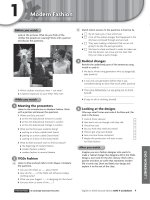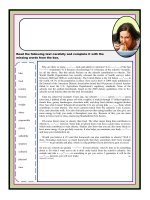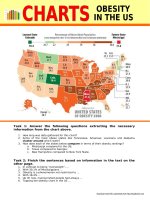4 1 1 bears in danger (expository nonfiction)
Bạn đang xem bản rút gọn của tài liệu. Xem và tải ngay bản đầy đủ của tài liệu tại đây (1.97 MB, 6 trang )
Reader
Genre
Expository
Nonfiction
Build Background
Access Content
Extend Language
• Conservation
• Florida Black
Bears
• Geography
• Definitions
• Labels and
Captions
• Bar Graph
• Fact Box
• Word Structure
• Suffix -ly
Scott Foresman Reading Street 4.1.1
ì<(sk$m)=bebihg< +^-Ä-U-Ä-U
ISBN 0-328-14187-9
Bears in
Danger
by Joanna Chen
Talk About It
1. What is an example of a human/bear conflict?
2. What are some programs for children and families
to help the Florida black bear?
Write About It
3. On a separate sheet of paper, write about
how human/bear conflicts have increased. Use
information from the bar graph on page 3 and
other pages in this book for facts.
Extend Language
You know that words ending with the suffix -ly often
are adverbs that tell about a verb. Find these adverbs
in the book and tell what they mean: rapidly (page 5);
constantly (page 6); carefully (page 8).
Bears in
Danger
by Joanna Chen
Photographs
Every effort has been made to secure permission and provide appropriate credit for photographic material. The
publisher deeply regrets any omission and pledges to correct errors called to its attention in subsequent editions.
Cover ©Lynn Rogers/Peter Arnold, Inc.; 1 ©Getty Images; 2 ©Leo Keeler/Animals/Earth
Scenes; 4 ©Getty Images; 5 ©Tony Arruza/Corbis; 6 ©Getty Images; 7 ©Tom Leeson/
Mira; 8 ©Lynn Rogers/Peter Arnold, Inc.
ISBN: 0-328-14187-9
Copyright © Pearson Education, Inc.
All Rights Reserved. Printed in the United States of America.
This publication is protected by Copyright, and permission should be obtained from
the publisher prior to any prohibited reproduction, storage in a retrieval system,
or transmission in any form by any means, electronic, mechanical, photocopying,
recording, or likewise. For information regarding permission(s), write to: Permissions
Department, Scott Foresman, 1900 East Lake Avenue, Glenview, Illinois 60025.
Editorial Offices: Glenview, Illinois • Parsippany, New Jersey • New York, New York
1234
5 6 7Offices:
8 9 10 Needham,
V0G1 14 13
12 11 10 09 08
07 06 05
Sales
Massachusetts
• Duluth,
Georgia • Glenview, Illinois
Coppell, Texas • Sacramento, California • Mesa, Arizona
ears
muzzle
Bears and People
Imagine this situation: You go out to your
backyard, and you see a bear sniffing your
garbage cans. Or you go into your garage to get
your bike and find a bear in there. What should
you do?
People in some parts of Florida think about
these situations a lot. They have been running into
black bears more and more. This is frightening and
dangerous for both bears and people.
The number of cases of people and bears
running into each other has gone up. In 1978,
just one case was reported. In 2002, 1,340 cases
were reported. These cases are called “conflicts”
by the Florida Fish and Wildlife Conservation
Commission.
The graph on this page shows the number of
conflicts each year from 1990 to 2002. Can you
tell during which years the number of conflicts
suddenly jumps up? If your answer is 1999 to
2000, you are right! You can see that in 2001,
the number went down. But in 2002, it went up
sharply. This graph shows clearly that the number
of conflicts in Florida is going up.
conservation: protection of the environment
Human/Bear Conflicts in Florida
1990–2002
1500
1340
1200
1133
Florida Black Bear Facts
• Description: Black body and head, brown muzzle,
and large ears that stick out
• Size: 150 to 600 pounds, 4.5 to 6.5 feet long
Number
Did You Know?
Human/Bear Conflicts
900
796
600
461
• Habitat: Heavily wooded land
356
300
228
208
• Food: Plants and small animals
86
95
104
389
143
90
0
1990 1991 1992 1993 1994 1995 1996 1997 1998 1999 2000 2001 2002
running into: meeting by chance
2
Year
3
These are some
examples of human/bear
conflicts.
• People who are hiking
see a bear in the woods
or in other places.
• Bears look for food in
areas where people live
or go.
• Bears walk across a
road where cars are
passing.
If you meet a Florida
black bear, it might stand
up and snort or make loud
blowing noises. The bear does this because it is
nervous. Florida black bears are not known to
attack people.
Extend Language
Word Structure
Sudden means “happening without warning,”
as in the sentence Emily gave a sudden scream. In
this sentence, the adjective sudden describes the
noun scream.
The suffix -ly turns adjectives like sudden into
adverbs that describe an action. For example:
The number of conflicts suddenly jumps up a lot.
How would you change these adjectives into
adverbs?
safe
4
rapid
constant
This road brings people to areas that have been habitats
of the Florida black bear.
Why are there more human/bear
conflicts today?
Some people think that human/bear conflicts
are going up in Florida because there are more
and more bears. Actually, it’s just the opposite.
The number of bears is going down. In the early
1900s, there were about 12,000 black bears in
Florida, southern Georgia, and southern Alabama.
Today, no one is really positive how many black
bears are left. People think the number is from
1,500 to 3,000 bears.
So why are human/bear conflicts increasing so
rapidly? There aren’t more bears, but there are
more people.
5
panther
Florida’s Growth
Florida is one of the fastest-growing states
in the country. The land that was home for the
black bear is being developed. Here are some
facts about how fast Florida is growing.
Population: Every day, between 500 and
1,000 new people come to live in Florida.
Roads: Every day, people drive about
246 million miles on Florida roads. More
roads are constantly being built or widened.
Many of these roads cut across conservation
areas, where many bears live.
Development: Every hour, nearly twenty acres
of natural areas are developed.
developed: having buildings or roads built on it
conservation areas: places where wildlife is protected
6
The black bear and panther can share a safe area.
Roads are bad for black bears because they
need a lot of land to survive. An adult male
needs 100 square miles to find food, shelter, and
a mate. When a road is built through this space,
it cuts up the area the bears need. It also brings
in vehicles. Vehicles are the greatest danger to
bears. Since 1976, more than 800 bears were
killed by vehicles on Florida roads.
Black bears roam over areas where many
other species of plants and animals live. If those
areas are protected for the black bear, they are
also protected for those plants and animals. This
is why people feel it is very important to help the
Florida black bear survive.
7
Talk About It
1. What is an example of a human/bear conflict?
2. What are some programs for children and families
to help the Florida black bear?
Write About It
3. On a separate sheet of paper, write about
how human/bear conflicts have increased. Use
information from the bar graph on page 3 and
other pages in this book for facts.
Extend Language
People are working to help the Florida black bear survive.
Help for the Bear
There are many people who want to protect
the Florida black bear. Here are some of the
things that people in Florida are doing:
• Teaching school children about the Florida
black bear with a special program that
includes a slide-show, games, and activities
• Selecting carefully where roads are built or
widened so that wild animals will not be
harmed by the traffic
• Holding a yearly festival for families with arts,
food, and information on the bear
Can you think of other things that people can
do to protect the Florida black bear?
You know that words ending with the suffix -ly often
are adverbs that tell about a verb. Find these adverbs
in the book and tell what they mean: rapidly (page 5);
constantly (page 6); carefully (page 8).
Photographs
Every effort has been made to secure permission and provide appropriate credit for photographic material. The
publisher deeply regrets any omission and pledges to correct errors called to its attention in subsequent editions.
Cover ©Lynn Rogers/Peter Arnold, Inc.; 1 ©Getty Images; 2 ©Leo Keeler/Animals/Earth
Scenes; 4 ©Getty Images; 5 ©Tony Arruza/Corbis; 6 ©Getty Images; 7 ©Tom Leeson/
Mira; 8 ©Lynn Rogers/Peter Arnold, Inc.
ISBN: 0-328-14187-9
Copyright © Pearson Education, Inc.
All Rights Reserved. Printed in the United States of America.
This publication is protected by Copyright, and permission should be obtained from
the publisher prior to any prohibited reproduction, storage in a retrieval system,
or transmission in any form by any means, electronic, mechanical, photocopying,
recording, or likewise. For information regarding permission(s), write to: Permissions
Department, Scott Foresman, 1900 East Lake Avenue, Glenview, Illinois 60025.
1 2 3 4 5 6 7 8 9 10 V0G1 14 13 12 11 10 09 08 07 06 05
8









